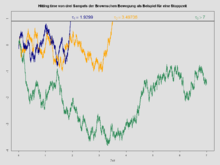Temps d'arrêt

En théorie des probabilités, en particulier dans l'étude des processus stochastiques, un temps d'arrêt (également appelé temps d'arrêt optionnel, et correspondant à un temps de Markov ou moment de Markov défini[1]) est une variable aléatoire dont la valeur est interprétée comme le moment auquel le comportement d'un processus stochastique donné présente un certain intérêt. Un temps d'arrêt est souvent défini par une règle d'arrêt, un mécanisme permettant de décider de poursuivre ou d'arrêter un processus sur la base de la position actuelle et des événements passés[2].
Ce temps d'arrêt peut être par exemple le moment où un processus stochastique prend fin, ou, dans un processus de Poisson et autres processus de Lévy à accroissements indépendants stationnaires, le moment d'un « saut » incrémental[2].
Cette notion de temps d'arrêt ne s'appuyant sur aucun évènement futur est étroitement lié à la propriété forte des processus de Markov[1].
Les temps d'arrêt jouent un rôle important dans la théorie de la décision, et dans les martingales, sont régis par le théorème d'arrêt de Doob (ou théorème d'arrêt optionnel)[2].
Définitions
Définition — Une variable aléatoire est un temps d'arrêt par rapport à une filtration si,
ou bien, de manière équivalente, si,
Interprétation
Imaginons que désigne ici la tribu engendrée par la suite et que les variables aléatoires représentent les résultats d'un joueur lors des parties successives d'un jeu. Dans le cas de variables aléatoires à valeurs dans un espace d'états fini ou dénombrable, une partie appartient à si et seulement s'il existe tel que
Supposons que représente le numéro de la partie après laquelle le joueur décide d'arrêter de jouer : est donc un temps d'arrêt si et seulement si la décision d'arrêter est prise en fonction des résultats des parties déjà jouées au moment de l'arrêt, i.e. si pour tout il existe un sous ensemble tel que :
L'instant où le joueur s'arrête est donc un temps d'arrêt si la décision d'arrêt ne tient pas compte des résultats des parties futures, donc sous l'hypothèse que don de double-vue et tricherie sont exclus.
Notations
- Soient une suite de variables aléatoires (un processus stochastique) et T un temps d'arrêt par rapport à une filtration . Le processus observé au temps T (ou arrêté au temps T) est noté et est défini par
- Sur l'ensemble la définition de est problématique : l'ambigüité est de facto levée en posant
- Soit un temps d'arrêt et soit
- est la variable aléatoire définie par
- est la variable aléatoire définie par .
Propriétés
Propriété — Soit un temps d'arrêt, soit . Alors et sont des temps d'arrêt.
On ne démontrera que le premier point, les deux autres étant semblables :
Or
Propriété — De même, si sont des temps d'arrêt, alors en est un.
Définition et propriété — Soit un temps d'arrêt et est appelé évènement antérieur à si:
L'ensemble de ces évènements forme une sous-tribu de appelée tribu antérieure à et notée
- contient
- est stable par réunion dénombrable
- Soit . On a D'où
,
et est stable par complémentarité.Proposition — Soient et deux temps d'arrêt tels que p.s.. On a alors .
Soit , c’est-à-dire . Comme de plus p.s., . Par suite,
Or et car est un temps d'arrêt. Donc
Lemme — Soit une variable aléatoire -mesurable. est -mesurable ssi est -mesurable.
- Sens réciproque
est -mesurable. avec
Or
Donc
Finalement est -mesurable.
- Sens direct
avec de plus . D'où (d'après la définition de ). Donc est -mesurable.
Proposition — est -mesurable.
avec qui sont -mesurable, d'où est -mesurable. D'après le lemme précédent, est -mesurable.
Exemples et contre-exemples
Considérons une suite de variable aléatoires, à valeurs dans un ensemble et notons la tribu engendrée par la suite Les variables aléatoires ci-dessous sont des temps d'arrêt pour la filtration :
- Soit un élément de ; on appelle instant de premier retour en et on note la variable aléatoire définie ci-dessous :
- De même pour une partie de on appelle instant de première entrée dans et on note la variable aléatoire ci-dessous définie :
- L'instant de -ème retour en noté et défini par récurrence par :
- ou encore l'instant de -ème entrée dans sont des temps d'arrêt.
- Pour et dans on pose On peut montrer que n'est pas un temps d'arrêt, mais que, par contre, est un temps d'arrêt.
Références
- ↑ a et b (en) Michiel Hazewinkel, Encyclopaedia of Mathematics, Springer Science & Business Media, (ISBN 978-94-009-5991-0, lire en ligne), p. 100, 110.
- ↑ a b et c (en) Geoffrey Grimmett et David Stirzaker, Probability and random processes, Oxford ; New York : Oxford University Press, (ISBN 978-0-19-857223-7 et 978-0-19-857222-0, lire en ligne), p. 263, 264, 498, 499.
Articles connexes
 Portail des probabilités et de la statistique
Portail des probabilités et de la statistique



































































































